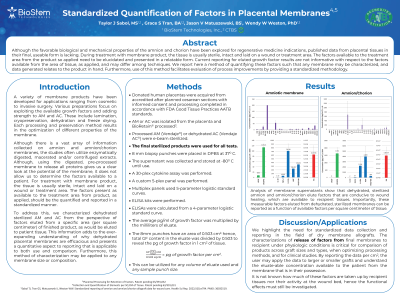Laboratory Research
(LR-044) Standardized Quantification of Factors in Placental Membranes
Friday, April 28, 2023
7:15 PM - 8:30 PM East Coast USA Time

Grace Tran, BA, CTBS – Lead Processing Technician, BioStem Technologies; Jason Matuszewski, BS – Chief Executive Officer, BioStem Technologies; Wendy Weston, PhD, CTBS – VP Research and Development, BioStem Technologies
Introduction: Although the favorable biological and mechanical properties of the amnion and chorion have been explored for regenerative medicine indications, published data from placental tissues in their final, useable form is lacking. During treatment with membrane product, the tissue is usually sterile, intact and laid on a wound or treatment area. The factors available to the treatment area from the product so applied need to be elucidated and presented in a relatable form. Current reporting for eluted growth factor results are not informative with respect to the factors available from the area of tissue, as applied, and may differ among techniques. We report here a method of quantifying these factors such that any membrane may be characterized, and data generated relates to the product in hand. Furthermore, use of this method facilitates evaluation of process improvements by providing a standardized methodology.
Methods: We characterized dehydrated sterilized AM and AC from the perspective of factors eluted from a specific area (per square centimeter) of finished product, as would be eluted to patient tissue.
Results: Analysis of membrane supernatants show that dehydrated, sterilized amnion and amnion/chorion elute factors that are conducive to wound healing, which are available to recipient tissues. Importantly, these measurable factors eluted from dehydrated, sterilized membranes can be reported as a function of available factors per square centimeter of tissue.
Discussion: We highlight the need for standardized data collection and reporting in the field of dry membrane allografts. The characterizations of release of factors from final membranes to recipient under physiologic conditions is critical for comparison of products across graft sizes and types, when optimizing processing methods, and for clinical studies. By reporting the data per cm2, the user may apply the data to larger or smaller grafts and understand the eluate-able concentration available to the patient from the membrane that is in their possession. It is not known how much of these factors are taken up by recipient tissues nor their activity at the wound bed, hence the functional effects must still be investigated.
Methods: We characterized dehydrated sterilized AM and AC from the perspective of factors eluted from a specific area (per square centimeter) of finished product, as would be eluted to patient tissue.
Results: Analysis of membrane supernatants show that dehydrated, sterilized amnion and amnion/chorion elute factors that are conducive to wound healing, which are available to recipient tissues. Importantly, these measurable factors eluted from dehydrated, sterilized membranes can be reported as a function of available factors per square centimeter of tissue.
Discussion: We highlight the need for standardized data collection and reporting in the field of dry membrane allografts. The characterizations of release of factors from final membranes to recipient under physiologic conditions is critical for comparison of products across graft sizes and types, when optimizing processing methods, and for clinical studies. By reporting the data per cm2, the user may apply the data to larger or smaller grafts and understand the eluate-able concentration available to the patient from the membrane that is in their possession. It is not known how much of these factors are taken up by recipient tissues nor their activity at the wound bed, hence the functional effects must still be investigated.

.png)